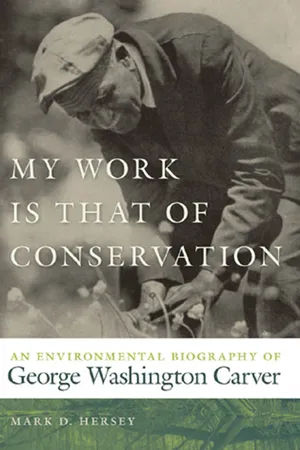![]()
NOTES
Prologue
1. George Washington Carver, “A Few Hints to Southern Farmers,” The Southern Workman and Hampton School Record (September 1899).
2. Joseph J. Ellis, American Sphinx: The Character of Thomas Jefferson (New York: Vintage Books, 1998).
3. See Saturday Night Live, season 10, episode 9 (December 15, 1984); Seinfeld, season 3, episode 10, “The Stranded” (1991); American Dad, season 2, episode 13, “Black Mystery Month”; Stevie Wonder, “Same Old Story,” on Stevie Wonder’s Journey through the Secret Life of Plants (1979).
4. See, for instance, Modern Marvels: George Washington Carver Tech, History Channel, 2005.
5. This is just one example. In June 2005 the Kansas City Star ran an article in which Lewis W. Diuguid used Carver to attack Missouri governor Matt Blunt for allowing a Confederate flag to fly at the Confederate Memorial State Historic Site, insisting that “Blunt needs to see this beautiful history of a black man [Carver] saving America.” See “Lewis W. Diuguid, “Let’s Remember Our Heroes,” Kansas City Star, June 17, 2005, B9.
6. Perhaps the best example of this is Barry Mackintosh, “George Washington Carver: The Making of a Myth,” Journal of Southern History 42 (November 1976): 507–28.
7. Linda O. McMurry, George Washington Carver: Scientist and Symbol (New York: Oxford University Press, 1981); Gary Kremer, George Washington Carver: In His Own Words (Columbia: University of Missouri Press, 1987).
8. See David Donald, “An Ambitious Figure,” New Republic, October 28, 1981, 36.
9. McMurry pointed this out, but Donald and others overlooked the point.
10. On Carver’s opportunity to pursue a PhD, see George Washington Carver (henceforth GWC) to Booker T. Washington (henceforth BTW), May 30, 1898, box 4, George Washington Carver Papers, Tuskegee University Archives, Tuskegee, Alabama (henceforth, GWCP, TUA); and GWC to BTW, July 9, 1900, GWCP, TUA, box 4, folder 5. Linda McMurry has made a similar argument in Linda O. McMurry, “A Vision of the Future?: George Washington Carver’s Approach to Technology and Nature,” unpublished paper. I am indebted to her for sharing this paper with me. Note: The Tuskegee University Archives, including the George Washington Carver Papers, have recently been reorganized under the guidance of Dan Chandler. This document and all others from the archives are cited as they were found under the old system.
11. McMurry, George Washington Carver, 311.
12. Peter Duncan Burchard, George Washington Carver: For His Time and Ours: Special History Study—Natural History Related to George Washington Carver National Monument, Diamond, Missouri (National Park Service, 2005).
13. The prevalence of the Hetch Hetchy controversy is evident in its incorporation into traditional textbook narratives. James Oakes et al., Of the People (2010), for example, devotes three paragraphs to the conservation movement in the text, but includes a two-page inset on the fight over the Hetch Hetchy Valley, ultimately concluding that “the battle for the valley gave birth to a modern environmental movement” (716). See James Oakes, Michael McGerr, Jan Ellen Lewis, Nick Cullather, and Jeanne Boydston, Of the People: A History of the United States (New York: Oxford University Press, 2010), 714–16. The classic (and hugely influential) work in terms of framing the nascent conservation movement in such terms is Samuel P. Hays, Conservation and the Gospel of Efficiency: The Progressive Conservation Movement, 1890–1920 (1959; reprint New York: Atheneum, 1975).
14. Quoted in Edna D. Bullock, Agricultural Credit (New York: H. H. Wilson, 1915), 34.
15. GWC to A. C. True, September 16, 1902; George Washington Carver, Possibilities of the Sweet Potato in Macon County, TAES Bulletin 17 (March 1910), 5.
Chapter 1. Were It Not for His Dusky Skin
1. Rackham Holt, who completed Carver’s “authorized” biography in consultation with him shortly before his death, devoted 117 pages—more than a third of her book—to his pre-Tuskegee years. See Rackham Holt, George Washington Carver: An American Biography (Garden City, N.Y.: Doubleday, 1943). The best account of Carver’s early years is in McMurry, George Washington Carver, 3–45.
2. Gary R. Kremer, In His Own Words, 20, 22. For Carver providing 1864 as the year of his birth, see the two “authorized” biographies of Carver: Raleigh H. Merritt, From Captivity to Fame, or, The Life of George Washington Carver (Boston: Meador, 1929); and Holt, George Washington Carver. Following the National Park Service Study that concluded that Carver was born in 1860, Holt amended her book accordingly.
3. Anna Coxe Toogood, Historic Resource Study and Administrative History, George Washington Carver National Monument, Diamond, Missouri (Denver, 1973), 6.
4. Quoted in ibid., 18.
5. See ibid., 2–21, for an in-depth discussion of the controversy over Carver’s birth date.
6. Ibid., 19.
7. McMurry, George Washington Carver, 10.
8. See “Moses Carver and His Family,” folder 622, Archives of the George Washington Carver National Monument, Diamond, Missouri (henceforth GWCNM).
9. For the census figures on Moses Carver’s livestock and produce from 1850–80, see Toogood, Historic Resource Study, 49.
10. The slave schedule for Newton County is available online at http://freepages.history.rootsweb.ancestry.com/~cappscreek/1860slave.html, accessed July 1, 2010.
11. Jim was listed as a mulatto in the census records, and consequently had...
